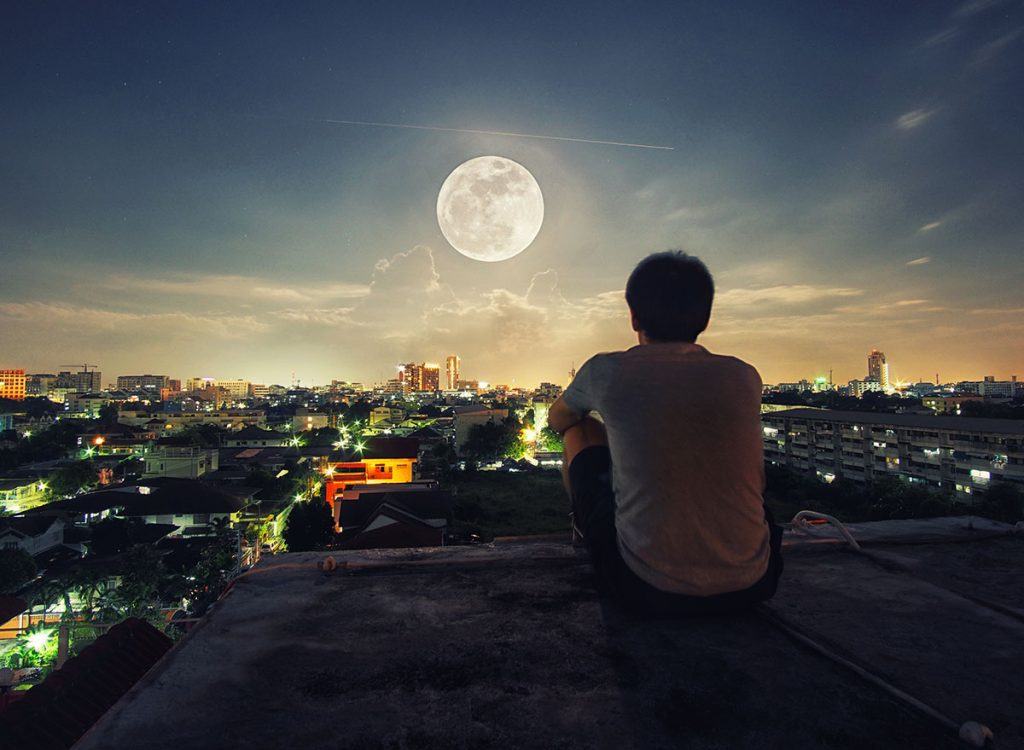The Full Flower Moon Will Light Up the Sky Tonight—And Illuminate a “Surprise”

Even though it has plenty of recognizable points of interest, the night sky is a constantly changing for those of us looking at it from down on Earth. There’s the monthly cycle of moon phases, constellations coming in and out of view with the passing of each season, and even special events like eclipses or meteor showers. And tonight marks one of those pretty unique occasions as the Full Flower Moon will light up the sky—along with a special “surprise” for stargazers. Read on to see how you can spot this remarkable astronomical sight.
READ THIS NEXT: 6 Stargazing Secrets, According to Astronomy Experts.
Tonight marks the appearance of the Full Flower Moon.

Even if you’re not the most eagle-eyed stargazer, it will be hard to miss the full moon’s brightness when it rises in the sky tonight. The event is known as the Flower Moon in May, which comes from a North American indigenous people’s description referencing the blooming of spring flowers that’s also underway, according to the Farmer’s Almanac.
The moon will reach its fullest phase during daylight hours in North America on Friday afternoon, but our orbiting satellite will already appear full in the sky tonight and before sunrise in the early morning hours of May 5, according to astronomy reference website Earth Sky. The full moon will then appear again just after sunset on Friday, May 5, appearing low in the sky to the southeast as it rises. If the weather in your area isn’t ideal, you’ll still have a chance to see what appears to be a full moon on the night of May 6, thanks to the cycle’s timing this month.
You’ll also be able to catch a bit of a “surprise” near the brightly lit moon.

Those who manage to get a glimpse at the sky on the night of May 5 will also get a special treat. The Full Flower Moon will be situated near the constellation Libra, putting it in close range to a moderately bright star known as Zubenelgenubi. The astronomical landmark is known as a “surprise” star because those who look carefully can often make out that it’s actually two stars close together, per Earth Sky.
The moon will be a helpful guide to pinpointing the special sight all night. And while some may be able to catch the double stars without any instruments, a pair of binoculars will make the view even clearer.
Those who are looking to add another star to their checklist should also keep their eyes peeled for Antares. The red star is a part of the Scorpius constellation, which will also be near the moon on the night of May 5, according to Earth Sky.
RELATED: For more up-to-date information, sign up for our daily newsletter.
You can also catch an impressive meteor shower on the night of May 5.

But the surprise star and full moon aren’t the only notable astronomical events happening on Friday evening: The Eta Aquarid meteor shower is underway and will hit its peak on the same night. And while the event produces a worthwhile spectacle annually, this year’s could be an even more memorable experience.
“They are projected to have a significant outburst on the night of May 4 [and] 5,” Bill Cooke, the lead for NASA’s Meteoroid Environment Office at NASA’s Marshall Space Flight Center in Alabama, told Space.com. He added that the surge “will be caused by particles ejected from Comet Halley way back in 390 [BCE], and rates should be over two times the norm.”
The extra active skies will be a boost for an annual event already known for “exhibiting bright meteors/fireballs, so it could be a pretty decent show,” Cooke said.
Here’s how to get the best view of tonight’s astronomical events.

If you’re looking for the best stargazing experience for tonight’s events, there are a few pointers to keep in mind before you set out. Ironically, while the full moon might be a spectacle unto itself, its brightness will also affect the viewing conditions for meteors. Still, you can get better overall results—and an easier glimpse of Zubenelgenubi—if you head to an area with as little light pollution as possible, according to Earth Sky.
Once you’ve found a good spot, you’ll need about 30 minutes for your eyes to adjust to the dark and become primed for stargazing. Avoid looking at your phone as you settle in, and consider using a flashlight with a red light feature to cut down on glare and spare your eyes from the brightness while you get situated, Earth Sky suggests.
As the Eta Aquarids won’t appear above the horizon until late into the night, those planning to catch the moon and the meteor shower should prepare for a long evening. Make sure to dress warmly and bring a comfortable blanket or chair that makes it easy to lie back and take in as much of the sky as possible.